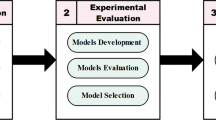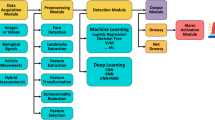Abstract
Due to factors such as snow and ice impeding drivers’ vision, the number of automobile crashes significantly rises during winter months. This study sets forth an automatic evaluation network of the risk perceived ability for motorists driving on the freeway in snow and ice environments, using a deep learning approach and the rough sets technique. First, a naturalistic driving experiment involving thirteen licensed drivers was conducted on a freeway in Jilin, China, with a crash hot spot set prior to the start of the experiment. Then multi-sensor (eye-trackers, mini-cameras, and speed detectors) apparatuses, collecting both images and numerical data, were utilized. Afterward, restricted Boltzmann machine was used to develop a deep belief network (DBN) along with training procedures. Rough sets technique was added as judgment in output layer of the DBN. Finally, fixation duration, pupil size, changes in speed, etc., were used as input impact factors and the perception conditions were used as output variables to train the network. Furthermore, after comparing the DBN-based risk perception ability network with Naïve Bayes and BP-ANN (artificial neural networks with back propagations), the results indicate that the DBN-FS not only outperforms both Naïve Bayes and BP-ANN, but also improves the accuracy of perceiving risky conditions. This approach can provide reference for the design of hazard detection systems of partially automated vehicles.








Similar content being viewed by others
References
Assum T (1997) Attitudes and road accident risk. Accid Anal Prev 29(2):153–159
Bamberg J, Cairns G, Kilminster D (2003) The crystallographic restriction, permutations, and Goldbach’s conjecture. Ame Math Mon 110(3):202–209
Button K, Taylor S (2000) International air transportation and economic development. J Air Transp Manag 6(4):209–222
Charlton SG (2007) The role of attention in horizontal curves: a comparison of advance warning, delineation, and road marking treatments. Accid Anal Prev 39(5):873–885
Chen J, Huang H, Tian S, Qu Y (2009) Feature selection for text classification with Naïve Bayes. Expert Syst Appl 36(3):5432–5435
Dahl GE, Yu D, Deng L, Acero A (2012) Context-dependent pre-trained deep neural networks for large-vocabulary speech recognition. IEEE Trans Audio Speech Lang Process 20(1):30–42
Dong D, McAvoy TJ (1995). Multi-stage batch process monitoring. In: Proceedings of the 1995 American control conference. IEEE, vol 3, pp 1857–1861
Faber MH, Stewart MG (2003) Risk assessment for civil engineering facilities: critical overview and discussion. Reliab Eng Syst Saf 80(2):173–184
Fischer A, Igel C (2014) Training restricted Boltzmann machines: an introduction. Pattern Recognit 47(1):25–39
Francis CM, Saurola P (2004) Estimating components of variance in demographic parameters of Tawny Owls, Strix aluco. Anim Biodivers Conserv 27(1):489–502
Herrera-Viedma E, Cabrerizo FJ, Kacprzyk J, Pedrycz W (2014) A review of soft consensus models in a fuzzy environment. Inf Fusion 17:4–13
Highway Traffic Safety Administration, N., and U. Department of Transportation. (2013). Research Note: 2013 Motor Vehicle Crashes: Overview
Highway Traffic Safety Administration N, U Department of Transportation (2012) Research Note: 2012 motor vehicle crashes: overview
Khanzode VV, Maiti J, Ray PK (2012) Occupational injury and accident research: a comprehensive review. Saf Sci 50(5):1355–1367
Kollar T, Tellex S, Roy D, Roy N (2010). Toward understanding natural language directions. In 2010 5th ACM/IEEE international conference on human–robot interaction (HRI). IEEE, pp 259–266
Li-sheng J, Wen-ping F, Ying-nan Z, Shuang-bin Y, Hai-jing H (2009). Research on safety lane change model of driver assistant system on highway. In: Intelligent vehicles symposium, 2009 IEEE. IEEE, pp 1051—1056
Liu YC, Wu TJ (2009) Fatigued driver’s driving behavior and cognitive task performance: effects of road environments and road environment changes. Saf Sci 47(8):1083–1089
Pasetto M, Barbati SD (2012) When the road layout becomes persuasive for the road users: a functional study on safety and driver behaviour. Proc Soc Behav Sci 48:3274–3283
Rodríguez RM, Martínez L, Torra V, Xu ZS, Herrera F (2014) Hesitant fuzzy sets: state of the art and future directions. Int J Intell Syst 29(6):495–524
Salakhutdinov R, Murray I (2008). On the quantitative analysis of deep belief networks. In: Proceedings of the 25th international conference on machine learning. ACM, pp 872–879
Saravanan N, Ramachandran KI (2010) Incipient gear box fault diagnosis using discrete wavelet transform (DWT) for feature extraction and classification using artificial neural network (ANN). Expert Syst Appl 37(6):4168–4181
Schmidhuber J (2015) Deep learning in neural networks: an overview. Neural Netw 61:85–117
Wang XT, Chang CC, Lin CC, Li MC (2012) A novel multi-group exploiting modification direction method based on switch map. Signal Process 92(6):1525–1535
Yin J, Zhao W (2016) Fault diagnosis network design for vehicle on-board equipments of high-speed railway: a deep learning approach. Eng Appl Artif Intell 56:250–259
Yu R, Abdel-Aty M (2013) Utilizing support vector machine in real-time crash risk evaluation. Accid Anal Prev 51:252–259
Acknowledgements
I have disclosed those interests fully to Research Projects of Social Science and Humanity on Young Fund of the Ministry of Education of China (16YJCZH157), while this work also supported by Social science planning project of Inner Mongolia (2015JDA008) and National Natural Science Foundation of China (71764020).
Author information
Authors and Affiliations
Corresponding author
Ethics declarations
Conflict of interest
No potential conflict of interest was reported by the authors.
Additional information
Communicated by M. Anisetti.
Rights and permissions
About this article
Cite this article
Zhao, W., Xu, L., Bai, J. et al. Sensor-based risk perception ability network design for drivers in snow and ice environmental freeway: a deep learning and rough sets approach. Soft Comput 22, 1457–1466 (2018). https://doi.org/10.1007/s00500-017-2850-x
Published:
Issue Date:
DOI: https://doi.org/10.1007/s00500-017-2850-x




